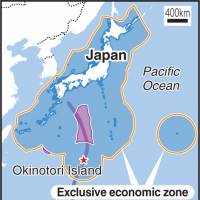The Cabinet approved an ordinance Tuesday to expand Japan's continental shelf outside its exclusive economic zone to gain access to rare metals and other untapped natural resources under the seafloor.
The ordinance, which will take effect Oct. 1, covers a combined 177,000 sq. km in waters off Okinotori Island, Japan's southernmost territory around 1,700 km from Tokyo.
"It will help Japan to enhance its national interests through the development of resources," Chief Cabinet Secretary Yoshihide Suga, the top government spokesman, said at a regularly scheduled news conference.
Prime Minister Shinzo Abe ordered the crafting of a government ordinance in July.
In a recommendation in April 2012, the U.N. Commissions on the Limits of the Continental Shelf recognized Japan's continental shelf as being around 310,000 sq. km — equivalent to about 80 percent of the country's total land area.
But the commission put off a decision on an area south of Okinotori Island, the southern Kyushu-Palau ridge, with China and South Korea opposed to the expansion based on the argument that Okinotori does not qualify as an island.
Suga said Japan will "work strenuously so a recommendation will be made at an early date" over the pending issue.
Under the U.N. Convention on the Law of the Sea, a coastal state can claim control of the seabed beyond the traditional 200 nautical mile limit for its exclusive economic use if it can prove the ocean floor is connected to its continental shelf.



